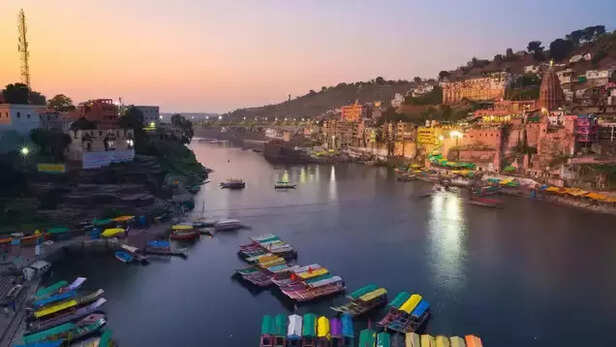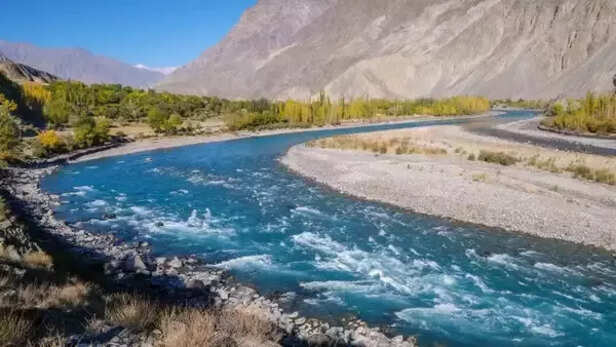5 Indian Rivers Where Pilgrims Believe You Can Wash Away Bad Karma
Riya Kumari | May 15, 2025, 23:44 IST

( Image credit : Times Life Bureau )
You know that feeling when you’ve royally messed up, eaten too much guilt pie, and your bad karma is basically collecting frequent flyer miles? Well, turns out, there are places in India where you can actually wash that stuff away. Yup, like a spiritual rinse cycle for your soul. And spoiler alert: these rivers aren’t just any rivers. They’re kind of like the VIP lounges of cleansing your cosmic mess.
There’s a simple human truth we all wrestle with: the weight of our mistakes, the quiet burden of regret, and the desire for a fresh start. Across centuries and cultures, people have searched for ways to undo what feels undone, to clear what clogs the heart and mind. In India, this hope finds a powerful symbol in the rivers believed to wash away bad karma. But here’s the thing — these rivers are not magic soaps that erase guilt with a flick of the wrist. They are invitations to pause, reflect, and surrender parts of ourselves that no longer serve us. The pilgrims who come to these waters understand that cleansing is both literal and metaphorical. The river becomes a mirror — for humility, for faith, and for renewal.
1. The Ganges

The Ganges is more than a river. It carries the prayers, sorrows, and aspirations of millions. To bathe in the Ganges is to step into a tradition that honors human imperfection. It reminds us that mistakes are part of the journey, not the destination.
When pilgrims immerse themselves here, they are not just washing away “sins.” They are acknowledging the weight of their past and choosing to release it, trusting that the current will carry it far enough for a new beginning. The Ganges teaches us that cleansing requires courage — to face our faults openly and hope for grace.
2. The Yamuna

The Yamuna flows quietly beside great monuments, reminders of love, loss, and endurance. Here, the act of purification is deeply personal yet shared with the flow of time itself. To enter the Yamuna’s waters is to connect with history, with the lives lived before us, and with the resilience needed to forgive ourselves.
In a world that rushes, the Yamuna urges patience. It asks us to understand that healing is a process, not a moment. It encourages us to embrace the complexity of life and to be gentle with our own hearts.
3. The Godavari

The Godavari winds through the heart of the south, a living thread connecting diverse lives and stories. This river’s strength lies in its continuity — it reminds us that renewal is not a one-time act but a steady flow.
Pilgrims who seek cleansing here show us the power of persistence in spiritual growth. Their rituals invite us to keep moving forward, even when the weight of our past seems too much to bear. The Godavari’s wisdom is simple: life’s burdens can be lightened by steady hope and deliberate action.
4. The Narmada

Unlike many rivers, the Narmada flows westward, quietly charting its own course. This rebel river invites us to look within, to walk the path of self-examination and transformation. The pilgrims who undertake the Narmada Parikrama—a demanding journey around the river’s length—show us the depth of commitment needed for true cleansing.
It’s not just about immersion in water but immersion in reflection and discipline. Narmada teaches us that washing away bad karma means facing discomfort and embracing the slow, sometimes difficult work of change.
5. The Saraswati

Saraswati is perhaps the most mysterious — a river that may have disappeared physically but remains alive in faith and memory. Its unseen flow reminds us that not all cleansing is visible or immediate.
The belief in Saraswati urges us to trust in the unseen forces that shape our lives. It reminds us that transformation can happen quietly, beneath the surface, beyond what eyes can see. Sometimes, the greatest cleansing is internal — a subtle shift in perspective, a quiet acceptance.
The Deeper Lesson
These rivers are not just bodies of water; they are symbols of an ancient wisdom that still speaks to us today. The promise of washing away bad karma is not about erasing mistakes or pretending they never happened. It is about understanding that we are more than our errors, that we have the power to let go and grow.
What these pilgrimages truly offer is a chance to slow down, to confront our own stories, and to step forward with humility and hope. Whether or not you believe in the sacred power of these waters, their message is clear: cleansing is a process of heart and mind, a choice to carry less burden and live more freely.
1. The Ganges

Ganga
( Image credit : Times Life Bureau )
The Ganges is more than a river. It carries the prayers, sorrows, and aspirations of millions. To bathe in the Ganges is to step into a tradition that honors human imperfection. It reminds us that mistakes are part of the journey, not the destination.
When pilgrims immerse themselves here, they are not just washing away “sins.” They are acknowledging the weight of their past and choosing to release it, trusting that the current will carry it far enough for a new beginning. The Ganges teaches us that cleansing requires courage — to face our faults openly and hope for grace.
2. The Yamuna

Yamuna
( Image credit : Times Life Bureau )
The Yamuna flows quietly beside great monuments, reminders of love, loss, and endurance. Here, the act of purification is deeply personal yet shared with the flow of time itself. To enter the Yamuna’s waters is to connect with history, with the lives lived before us, and with the resilience needed to forgive ourselves.
In a world that rushes, the Yamuna urges patience. It asks us to understand that healing is a process, not a moment. It encourages us to embrace the complexity of life and to be gentle with our own hearts.
3. The Godavari

Godavari
( Image credit : Times Life Bureau )
The Godavari winds through the heart of the south, a living thread connecting diverse lives and stories. This river’s strength lies in its continuity — it reminds us that renewal is not a one-time act but a steady flow.
Pilgrims who seek cleansing here show us the power of persistence in spiritual growth. Their rituals invite us to keep moving forward, even when the weight of our past seems too much to bear. The Godavari’s wisdom is simple: life’s burdens can be lightened by steady hope and deliberate action.
4. The Narmada

Narmada
( Image credit : Times Life Bureau )
Unlike many rivers, the Narmada flows westward, quietly charting its own course. This rebel river invites us to look within, to walk the path of self-examination and transformation. The pilgrims who undertake the Narmada Parikrama—a demanding journey around the river’s length—show us the depth of commitment needed for true cleansing.
It’s not just about immersion in water but immersion in reflection and discipline. Narmada teaches us that washing away bad karma means facing discomfort and embracing the slow, sometimes difficult work of change.
5. The Saraswati

Saraswati
( Image credit : Times Life Bureau )
Saraswati is perhaps the most mysterious — a river that may have disappeared physically but remains alive in faith and memory. Its unseen flow reminds us that not all cleansing is visible or immediate.
The belief in Saraswati urges us to trust in the unseen forces that shape our lives. It reminds us that transformation can happen quietly, beneath the surface, beyond what eyes can see. Sometimes, the greatest cleansing is internal — a subtle shift in perspective, a quiet acceptance.
The Deeper Lesson
What these pilgrimages truly offer is a chance to slow down, to confront our own stories, and to step forward with humility and hope. Whether or not you believe in the sacred power of these waters, their message is clear: cleansing is a process of heart and mind, a choice to carry less burden and live more freely.
